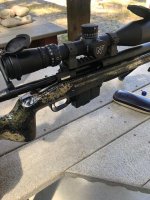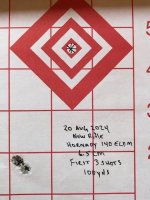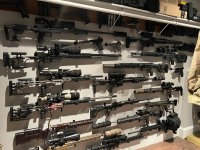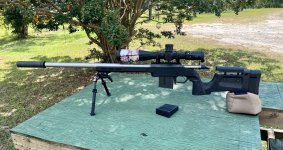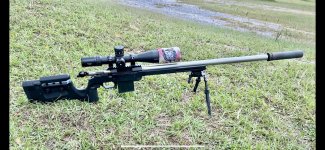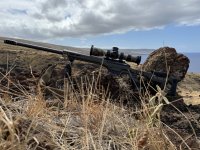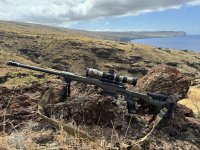It’s all good, I just noticed you were fairly new to the forum, so I was pointing you in the right direction, for if you need to search for AR/semi-auto advice, or start any semi-auto related threads in the future.Yeah my apologies. I didn’t realize I was posting in the “bolt action” section until after I posted it, went out and back in later.
Join the Hide community
Get access to live stream, lessons, the post exchange, and chat with other snipers.
Register
Download Gravity Ballistics
Get help to accurately calculate and scope your sniper rifle using real shooting data.

Install the app
How to install the app on iOS
Follow along with the video below to see how to install our site as a web app on your home screen.
Note: This feature may not be available in some browsers.
-
Having trouble using the site?
Contact support
You are using an out of date browser. It may not display this or other websites correctly.
You should upgrade or use an alternative browser.
You should upgrade or use an alternative browser.
To make up for my screw up in posting my 6.5CM AR-10 here in the bolt gun thread, here’s my dad’s Remington 700 chambered in 30-06 that I’m upgrading as I can. It was originally a BDL, but I always hated that stupid drop out plate, but he never wanted to change it. Getting the Brownell’s mag kit was the first thing I did after I inherited it. Also swapped out the glass (Vortex Crossfire II I had in the cabinet), and put a Harris bipod on it.
My next step is to get rid of the original chassis and upgrade it either to a Magpul’s Pro 700L or I’m also liking Tacmod’s precision stock. I really want the Accuracy International, but dropping $2k on just a chassis is a bit tough to swallow. I also want to swap the barrel so I can throw a can on it, but that’s a ways away. Plus this is one built in the early 90’s, so I don’t have to worry about the “crap stock 700 trigger” fiasco of the late 90’s/early 2000’s. But this is damn accurate. I used to shoot sub minute at 500 yards with it back when I was in junior high and high school. Hopefully when all said and done, I can find a place to really stretch its legs.

My next step is to get rid of the original chassis and upgrade it either to a Magpul’s Pro 700L or I’m also liking Tacmod’s precision stock. I really want the Accuracy International, but dropping $2k on just a chassis is a bit tough to swallow. I also want to swap the barrel so I can throw a can on it, but that’s a ways away. Plus this is one built in the early 90’s, so I don’t have to worry about the “crap stock 700 trigger” fiasco of the late 90’s/early 2000’s. But this is damn accurate. I used to shoot sub minute at 500 yards with it back when I was in junior high and high school. Hopefully when all said and done, I can find a place to really stretch its legs.
Oh I’ve got a bit of everything, with the exception of black powder (had one back in the day, got too impatient with actually shooting it and taking an hour between shots). So I’m sure I’ll be posting in many threads lol.It’s all good, I just noticed you were fairly new to the forum, so I was pointing you in the right direction, for if you need to search for AR/semi-auto advice, or start any semi-auto related threads in the future.
I don't want to clog up this thread but you may want to solicit recommendations for your planned upgrades in a thread at some point before buying anything. What to upgrade in what order, brands/models that will be the best bang for your buck (pun unintended), etc. Or whether you should do a bunch of upgrades to that particular rifle at all, versus maybe using it for hunting and building another bolt gun for long range. I don't know your experience level but those are just some thoughts.My next step is to get rid of the original chassis and upgrade it either to a Magpul’s Pro 700L or I’m also liking Tacmod’s precision stock. I really want the Accuracy International, but dropping $2k on just a chassis is a bit tough to swallow. I also want to swap the barrel so I can throw a can on it, but that’s a ways away. Plus this is one built in the early 90’s, so I don’t have to worry about the “crap stock 700 trigger” fiasco of the late 90’s/early 2000’s.
That’s solid advice. Truth be told, other than throwing glass on a rifle, upgrading my dad’s 700 is the first bolt action gun I will undertake. I’ve held the Magpul stock in my hands, the other two I’m going off pictures I’ve seen online. I really would want to hold them, index them, see how they feel. Don’t want to drop a grand on something I’m going to hate.I don't want to clog up this thread but you may want to solicit recommendations for your planned upgrades in a thread at some point before buying anything. What to upgrade in what order, brands/models that will be the best bang for your buck (pun unintended), etc.
In that case when the time comes you should absolutely start a thread soliciting some advice. Or search around for past threads on guys wanting to put together their first precision rifle. The biggest question is whether you have enough sentiment tied up in that rifle that, no matter what, you want to upgrade it instead of putting together a separate rifle that would end up being better.That’s solid advice. Truth be told, other than throwing glass on a rifle, upgrading my dad’s 700 is the first bolt action gun I will undertake. I’ve held the Magpul stock in my hands, the other two I’m going off pictures I’ve seen online. I really would want to hold them, index them, see how they feel. Don’t want to drop a grand on something I’m going to hate.
Truth be told, next to none. I mean I have sentiment in that I never plan on getting rid of it, but keeping it in it’s original configuration, or at least how my dad set it up, no, I’m not built that way. I get bored too easily and I’m always tinkering on something. I get that from him, so he’d understand.In that case when the time comes you should absolutely start a thread soliciting some advice. Or search around for past threads on guys wanting to put together their first precision rifle. The biggest question is whether you have enough sentiment tied up in that rifle that, no matter what, you want to upgrade it instead of putting together a separate rifle that would end up being better.
As far as building another rifle,, I have my Savage 110 7mm Mag, but it is the model that has the internal magazine built into the stock (forgive me, I was 15 when I picked it out and didn’t know better), so if I were to do that one I would have to take it down to the action only and start from scratch.
If I were to do that, I’d start brand new, change calibers and go up to something like a .338 of some kind (Lapua, Norma, WM, etc.). But to do that, knowing me, I’d spare no expense and Gucci and he hell out of it so we’re talking $$&-$10k minimum to build one the way I’d want it. I already did my Gucci AF build when I built my 8.6BLK last month, and the wife was pissed (at least until she shot it). At least with the 30-06, I can do a piece at a time and still take it to the range whenever I want.
First bolt action build. Seemed simpler/easier/(not cheaper), than putting an AR together. Everything literally fit together just about perfect. 6.5 CM, Zermatt TL3 LBRP action, Bartlein Heavy Palma/1-8 twist/24"(Done by Southern Precision Rifles), Manners Pro Hunter with Hawkins M5 bottom metal and a TriggerTech Diamond single stage. Put the thing together, went to the range, bore sighted it and this was literally the first 3 shots (Factory Hornady 140 ELD-M) through the thing.
Attachments
My 7-300 PRC at the moment (also has a .300WM barrel to swap back and forth with). Still getting stuff together to start playing with it this winter. Right now it is serving as a test bed for my loaner Zeiss S3.
-Older Prague OK Surgeon 1086
-27" Bartlein 1:8, heavy palma, with Area 419 Hellfire
-McM A5
-Surgeon bottom metal
-7-35 ATACR in Nightforce ultralight rings

-Older Prague OK Surgeon 1086
-27" Bartlein 1:8, heavy palma, with Area 419 Hellfire
-McM A5
-Surgeon bottom metal
-7-35 ATACR in Nightforce ultralight rings
So i was able to borescope it tonight and it looks horrible . Really bad machine /chatter marks. Looks like barrel swap in order for sure , but why change the chassis?I would recommend swapping out the barrel and chassis. I had a savage that was terrible and for 1400 extra bucks I got a one hole gun. To me it was cheaper than struggling to find ammo that would shoot etc.
Below
Picture is factory ammo, but honestly it shoots everything under 1 moa easy. It was a 3-4 moa gun prior to the smith work.
Remington 700 police in 300 win mag. 24" threaded barrel and leupold mark 4 hd 6-24.
Probably going to send it off to Badger to get bottom metal for aics and do a 300 prc conversion at local gunsmith.

Probably going to send it off to Badger to get bottom metal for aics and do a 300 prc conversion at local gunsmith.
Is the barrel steel or carbon fiber? It’s difficult to tellFirst bolt action build. Seemed simpler/easier/(not cheaper), than putting an AR together. Everything literally fit together just about perfect. 6.5 CM, Zermatt TL3 LBRP action, Bartlein Heavy Palma/1-8 twist/24"(Done by Southern Precision Rifles), Manners Pro Hunter with Hawkins M5 bottom metal and a TriggerTech Diamond single stage. Put the thing together, went to the range, bore sighted it and this was literally the first 3 shots (Factory Hornady 140 ELD-M) through the thing.
Damn that’s nice. The 300 WM to PRC, isn’t that just a barrel swap?Remington 700 police in 300 win mag. 24" threaded barrel and leupold mark 4 hd 6-24.
Probably going to send it off to Badger to get bottom metal for aics and do a 300 prc conversion at local gunsmith. View attachment 8485850
My gunsmith says he can use the same barrel and take a certain amount off the chamber and shorten the barrel so much where it goes into the receiver and set it back.Is the barrel steel or carbon fiber? It’s difficult to tell
Damn that’s nice. The 300 WM to PRC, isn’t that just a barrel swap?
I'm not exactly sure what all needs to be done, but I will research it more and talk to him more about it.
Yeah I would definitely look into that. I would think swapping the barrel would be easier, and better for the gun, than machining it down and chopping off the end. Not to mention, if you ever wanted to go back to the WM, you wouldn’t have to buy an entire new rifle.My gunsmith says he can use the same barrel and take a certain amount off the chamber and shorten the barrel so much where it goes into the receiver and set it back.
I'm not exactly sure what all needs to be done, but I will research it more and talk to him more about it.
Why would I have to buy a whole new rifle as all the work is done to the barrel not the action.Yeah I would definitely look into that. I would think swapping the barrel would be easier, and better for the gun, than machining it down and chopping off the end. Not to mention, if you ever wanted to go back to the WM, you wouldn’t have to buy an entire new rifle.
Why would I have to buy a whole new rifle as all the work is done to the barrel not the action.
Fair question, and I will try to share my opinion based off of doing several "custom builds" with Remington 700 actions over the years.
Please bear in mind that the Remington receivers are mass produced, and the chances of them being as square to a aftermarket action extremely slim to none. So, most gunsmiths will square the receiver face, and the bolt face, nose and locking lugs (more steps are frequently done too), as well as the recoil lug to try to eliminate the stacking of tolerances.
It's not always done just to improve accuracy, but also to improve the the overall feel of the action. Most 700 actions also come with 6-48 holes tapped for the scope base, so it is pretty common to get those drilled out to 8-40...which basically gives you a little bigger screws to use to secure your scope rail on top of your receiver. Same with the recoil lug, which will frequently be replaced with something thicker if it isn't just trued.
*****
Having a barrel cut and rechambered is basically the same cost as having a new aftermarket barrel chambered, but if you retain the OEM barrel, you are again using something that is mass-produced. That doesn't mean Remington barrels are guaranteed not to shoot. I could usually get mine to shoot pretty well with handloads. I'm simply stating that it is far easier to get a good aftermarket barrel to shoot well, foul less, and virtually eliminate that 'cold bore shift' of the first shot (especially when combined with a trued/aftermarket action).
By the time most guys get a 700 action blueprinted and barrel chambered (or rechambered in your case) you'll be out $500 - 800 dependingon how much you have done. Throw in the cost of purchasing said factory barreled action or rifle, and you're really close to the cost of a decent aftermarket action and barrel...which is why most guys go the latter route these days.
Adding here that factory stocks rarely fit a shooter as well as a good aftermarket one (or chassis), and those are frequently the first thing to get upgraded. By the time it is all said and done, most have invested enough to have had a custom rifle built. Your intended approach was a very common one 20 years ago, but with the abundance of aftermarket 'easy buttons', we can now assemble stuff that suits us better in the comfort of our own garages.
I don't know if anything that I've said makes sense to you or not, but I wish you the best of luck in whatever route you go.
I have a custom gun that I am waiting on delivery. I got this one for nostalgia reasons. I have no plan on changing the stock unless I change it to a m24 stock.Fair question, and I will try to share my opinion based off of doing several "custom builds" with Remington 700 actions over the years.
Please bear in mind that the Remington receivers are mass produced, and the chances of them being as square to a aftermarket action extremely slim to none. So, most gunsmiths will square the receiver face, and the bolt face, nose and locking lugs (more steps are frequently done too), as well as the recoil lug to try to eliminate the stacking of tolerances.
It's not always done just to improve accuracy, but also to improve the the overall feel of the action. Most 700 actions also come with 6-48 holes tapped for the scope base, so it is pretty common to get those drilled out to 8-40...which basically gives you a little bigger screws to use to secure your scope rail on top of your receiver. Same with the recoil lug, which will frequently be replaced with something thicker if it isn't just trued.
*****
Having a barrel cut and rechambered is basically the same cost as having a new aftermarket barrel chambered, but if you retain the OEM barrel, you are again using something that is mass-produced. That doesn't mean Remington barrels are guaranteed not to shoot. I could usually get mine to shoot pretty well with handloads. I'm simply stating that it is far easier to get a good aftermarket barrel to shoot well, foul less, and virtually eliminate that 'cold bore shift' of the first shot (especially when combined with a trued/aftermarket action).
By the time most guys get a 700 action blueprinted and barrel chambered (or rechambered in your case) you'll be out $500 - 800 dependingon how much you have done. Throw in the cost of purchasing said factory barreled action or rifle, and you're really close to the cost of a decent aftermarket action and barrel...which is why most guys go the latter route these days.
Adding here that factory stocks rarely fit a shooter as well as a good aftermarket one (or chassis), and those are frequently the first thing to get upgraded. By the time it is all said and done, most have invested enough to have had a custom rifle built. Your intended approach was a very common one 20 years ago, but with the abundance of aftermarket 'easy buttons', we can now assemble stuff that suits us better in the comfort of our own garages.
I don't know if anything that I've said makes sense to you or not, but I wish you the best of luck in whatever route you go.
That being said I had a discussion today with my local smith and we are researching cost for barrel replacement in 300 prc to see if it's a route I want to go down or of I will stick woth the 300 wm amd just get the bottom metal and eventually get a different rifle in 300 prc or even 300 norma.
Just got approval for my .338 suppressor.my contribution to the photo gallery.
1st pic is my Ruger .308 and second is Ruger .338 Lapua.
.308- 3.5-18 Leupold HD-5
Bartlein 22 inch barrel
Silencer Central suppressor with Modtac shield
BLK LBL hand guard w/ built in bipod
Target Tool stock (thanks to Will)
Grip and bolt shroud from Anarchy Outdoors
.338- 5-25 Leupold HD-5
Harris Bipod
Grip and bolt shroud from Anarchy Outdoors
Waiting on suppressor from Silencer Central. Should be soon.
What brand did you go with? I ordered a Porq Chop for my 8.6BLK build. A buddy of mine just got the can for his 8.6BLK build, he ordered a Dead Air Nomax 33. But even though it’s built for a .338 projectile, the mount isn’t made in M18x1.5 thread.Just got approval for my .338 suppressor.
bought it through Silencer Central. Banish 338What brand did you go with? I ordered a Porq Chop for my 8.6BLK build. A buddy of mine just got the can for his 8.6BLK build, he ordered a Dead Air Nomax 33. But even though it’s built for a .338 projectile, the mount isn’t made in M18x1.5 thread.
If you are on a budget keep the current stock and see how it shoots with a new barrel. My savage had a stock that flexed like Walmart Tupperware. If a stock flexes it could cause accuracy issues if it hits different parts of the rifle and barrel sporadically.So i was able to borescope it tonight and it looks horrible . Really bad machine /chatter marks. Looks like barrel swap in order for sure , but why change the chassis? View attachment 8485771
Specs on the scope mount height? I have a vision with top rail mount on the way gonna use a tangent. looking at getting the area419 either the 1.23 or 1.5. I like close gapsVision Pro Chassis
Fit and finish of this chassis is certainly top notch. Blows my MDT out of the water (still great chassis).
The folder is great.
View attachment 8469750View attachment 8469751View attachment 8469752
It's a 1.5 inch mount. It's unlikely to clear the top rail with a 1.26 if you intend to use a scope cap.Specs on the scope mount height? I have a vision with top rail mount on the way gonna use a tangent. looking at getting the area419 either the 1.23 or 1.5. I like close gaps
Also, if you plan on doing thermal or NV stuff... 1.5 is what you'll need.
Thank you for the quick reply! and good call with the NV info, always an option!It's a 1.5 inch mount. It's unlikely to clear the top rail with a 1.26 if you intend to use a scope cap.
Also, if you plan on doing thermal or NV stuff... 1.5 is what you'll need.
Still room for a barreled action in the Foundation.Ran out of room
We should have this same problem lolRan out of room
New rifle on a test, it is not MINE.
Because ich liebe KRG
But it is nice to test something different.
CZ 600 MDT Deep Bronze 308win.

Because ich liebe KRG
But it is nice to test something different.
CZ 600 MDT Deep Bronze 308win.
Is that a McMillan A6? I have one of those on order right now for my Deadline action. What length of Arca do you have on it?
Straight jacket armory barrelled action. Impact precision NBK, 7mm PRC Bartlien carbon barrel 22”, XLR element mg, 7-35 ATACR, XLR rings, Thunderbeast ultra7,
I too must confess my jealousy of the bench. Mine doesn’t look half that good (nor is it half as clean lol)Great bench/workspace
You really need to have a “Murica” sticker above the eagle. Especially in that first picture where it looks as if the rifle is in his talons.View attachment 8491695
Straight jacket armory barrelled action. Impact precision NBK, 7mm PRC Bartlien carbon barrel 22”, XLR element mg, 7-35 ATACR, XLR rings, Thunderbeast ultra7,
View attachment 8491685View attachment 8491682
Finally some more rimfire content, with the @christensenarms Ranger 22 and TBAC 22 TD. It's POV, so you can actually see me shooting (and see the bullets flying) downrange at the 300 yard gongs.
Put together a 6ARC build for fun with parts cannibalized from my 22LR and an extra Origin action I had laying around. Running a 20" 1:7.5 Benchmark spun up by Blue Mountain Precision. The brand new barrel is running 2671fps with factory Hornady 108gr eld match which was a pleasant surprise.


Man, I usually dislike all black rifles, but this is an exception! And Razor Gen2 master race! lol I really like my G2s. Not the absolute best scope ever but nice, love the 2c reticles I have, and big eyebox.Put together a 6ARC build for fun with parts cannibalized from my 22LR and an extra Origin action I had laying around. Running a 20" 1:7.5 Benchmark spun up by Blue Mountain Precision. The brand new barrel is running 2671fps with factory Hornady 108gr eld match which was a pleasant surprise.
View attachment 8492552
View attachment 8492553
What’s that plate that’s right before the magwell? A weight?
Haha thanks, yeah the gen 2 came off my 22LR. I run the gen 3's on my other rifles but this 6ARC is basically replacing the 22 in the safe and beyond the barrel I wanted to stick with parts I had laying around as much as possible before that whole "well maybe I should move one of the gen 3's over and then get a ZCO ..." train of thought takes offMan, I usually dislike all black rifles, but this is an exception! And Razor Gen2 master race! lol I really like my G2s. Not the absolute best scope ever but nice, love the 2c reticles I have, and big eyebox.
What’s that plate that’s right before the magwell? A weight?
Re: plate, yep that's a Gray Ops mini plate
Thinking I might give scenars a go this hunting season.



Started life as a Ruger American Predator in .223 Remington. Only remaining thing that’s Ruger is the action.
-Ruger American action
-Preferred Barrel Blanks 1.125” diameter 26” barrel chambered in .223 Ackley Improved
-MDT XRS chassis
-MDT .223 metal magazine
-Timney trigger set to 1.5lbs
-Atlas Cal bipod
-Glades Armory bolt handle
-Arken Optics SH4 GenII 6-24x50 in Arken rings
-Silencerco ASR brake with SWR SPECWAR 556 can
-Ruger American action
-Preferred Barrel Blanks 1.125” diameter 26” barrel chambered in .223 Ackley Improved
-MDT XRS chassis
-MDT .223 metal magazine
-Timney trigger set to 1.5lbs
-Atlas Cal bipod
-Glades Armory bolt handle
-Arken Optics SH4 GenII 6-24x50 in Arken rings
-Silencerco ASR brake with SWR SPECWAR 556 can
Attachments
Last edited:
Here are my two centerfire rigs:
Top - Seekins Havak Hit
18" MTU 6.5 CM barrel cut (poorly) by Straight Jacket Armory - later fixed by local Scheels smith
Trimmed the nose off of the cheek rest so I can remove the bolt without folding
Crosstac MK109 brake
Arken EP5 (hate if ya want, it works with my eyes nicely)
Area419 bolt knob and extension
Harris knockoff bipod
Timney Hunter (stock)
Ergo Deluxe grip
Bottom - Custom Kelblys Atlas Tactical
27" Hawk Hill 1:7 heavy varmint chambered in 223 Wylde
KMW Sentinel stock (bought here on the Hide, great transaction - hit up Terry Cross to see about a pic rail and he had one in the mail that day)
Trigger Tech Special
Crosstac MK109 brake
Burris XTRII 5-25x50
Accutac SR5

Top - Seekins Havak Hit
18" MTU 6.5 CM barrel cut (poorly) by Straight Jacket Armory - later fixed by local Scheels smith
Trimmed the nose off of the cheek rest so I can remove the bolt without folding
Crosstac MK109 brake
Arken EP5 (hate if ya want, it works with my eyes nicely)
Area419 bolt knob and extension
Harris knockoff bipod
Timney Hunter (stock)
Ergo Deluxe grip
Bottom - Custom Kelblys Atlas Tactical
27" Hawk Hill 1:7 heavy varmint chambered in 223 Wylde
KMW Sentinel stock (bought here on the Hide, great transaction - hit up Terry Cross to see about a pic rail and he had one in the mail that day)
Trigger Tech Special
Crosstac MK109 brake
Burris XTRII 5-25x50
Accutac SR5
God I love Sentinels!
Did I go too blue with the grey on this BA? Little bit smokier than I was expecting and doesn’t reeeealllly match the chassis colors. Still looks nice - I think?

Did I go too blue with the grey on this BA? Little bit smokier than I was expecting and doesn’t reeeealllly match the chassis colors. Still looks nice - I think?
Barrel’s/actions that exactly match the chassis/stock in color just never look right to me. That said, I think it looks really nice. A bit jealous I am.God I love Sentinels!
Did I go too blue with the grey on this BA? Little bit smokier than I was expecting and doesn’t reeeealllly match the chassis colors. Still looks nice - I think?
View attachment 8495340
Thinking I might give scenars a go this hunting season.
View attachment 8492954
View attachment 8492951
View attachment 8492950
MDT HNT26 locking folder both directions (Do not like it locking in the closed)
7 SAUM
MDT muzzle brake
Kahles K318 scope
Just added an Old Balls buttstock since my kids also shoot this hunting but recoil is pretty mild.
7 SAUM
MDT muzzle brake
Kahles K318 scope
Just added an Old Balls buttstock since my kids also shoot this hunting but recoil is pretty mild.
Attachments
Yep, Tangent Theta "M" series. So far it's been great. I've cycled through Bushnell Elite, SWFA for a minute, MK5, AMG, Kahles, ATACR, ZCO, and now Tangent. For where, what, and how I hunt, Tangent has paired the best, been most consistent/reliable, best hunting reticle, light enough, enough.What scope is on your rifle?Disregard just saw what looks to be Tangent Theta. How do you like it on your hunting rifle? I will add mine to this thread too since I did a photo shoot with mine out in the wild.
Similar threads
- Replies
- 11
- Views
- 2K
- Replies
- 0
- Views
- 1K
- Replies
- 1
- Views
- 1K
